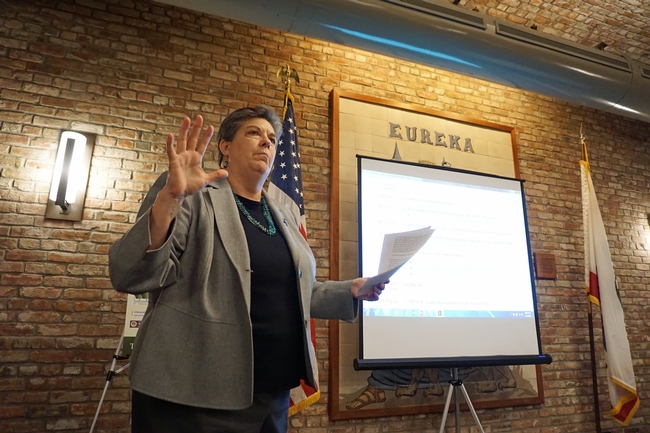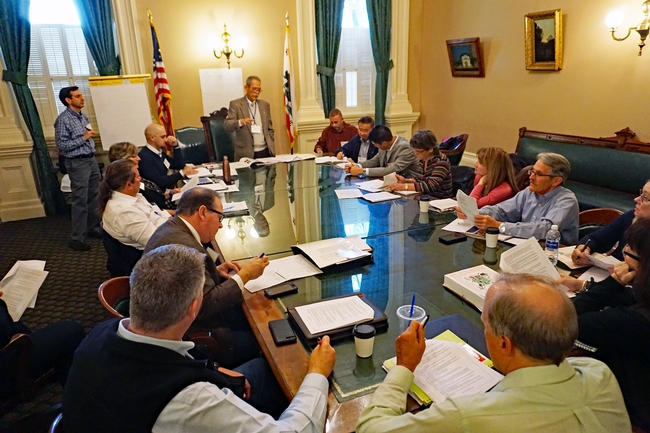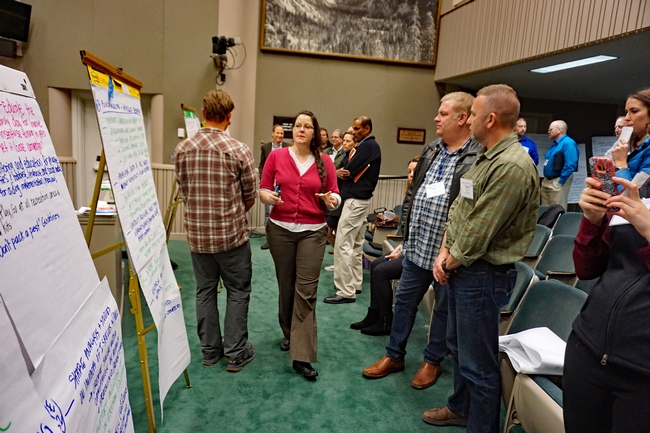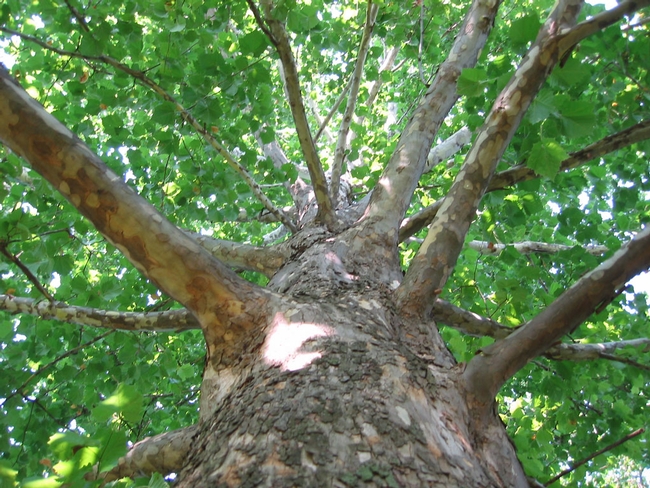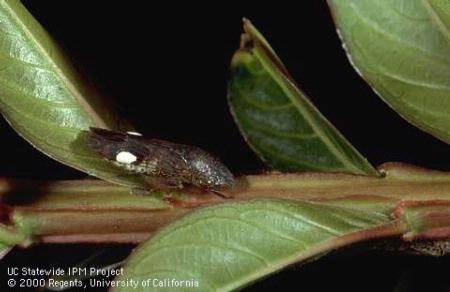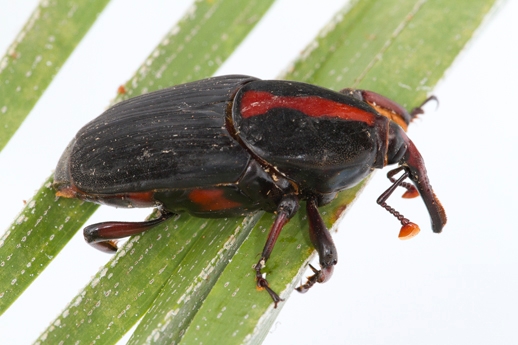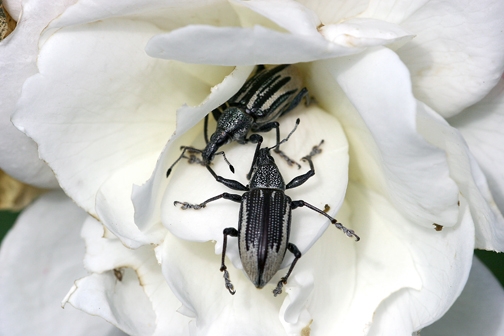Posts Tagged: John Kabashima
Ag leaders, scientists set priorities to prevent invasive pest threats to the environment and economy
The gypsy moth, an interloper from Europe and Asia, is threatening California's majestic oaks in Ventura County.
Invasive desert knapweed, which comes from Africa, has made its first North American appearance in in California's Anza-Borrego Desert, where it has started to crowd out native plants.
Asian citrus psyllids are slowly spreading the devastating huanglongbing disease in Southern California citrus.
River rats from South America, called nutrias, are munching voraciously on wetland plants in some areas of Stanislaus, Merced and Fresno counties.
These are just a few of the insects, weeds, animals and diseases that have entered the state of California from elsewhere on the globe, causing tremendous ecological damage and huge economic losses to agricultural crops, which ultimately affect every resident of California.
Based on historical data, a new invertebrate species establishes itself in California about every six weeks, on average. They don't all become serious pest problems, but many evade eradication efforts, disrupt carefully balanced integrated pest management programs, hijack sensitive ecosystems, and spoil valued recreational resources and urban landscapes.
A diverse group of university scientists, federal and state government representatives, county agricultural commissioners and non-profit organization leaders who are battling these pests converged at a summit in the state capitol Jan. 11 and 12 to coordinate their efforts, pool intellectual resources, and plot a strategy for protecting agricultural crops, natural resources, unique ecological communities, cityscapes and residential neighborhoods.
“We are a big, beautiful, special place, blessed with great weather and diverse geography,” said California Department of Food and Agriculture Secretary Karen Ross at the summit. “That means a lot to our many visitors – including pests.”
Glenda Humiston, vice president of UC Agriculture and Natural Resources, which co-sponsored the summit, outlined the goals.
“We know that collectively, we have the tools and expertise to prevent invasive species from entering California, spreading and becoming established,” Humiston said. “I am so pleased with the numbers of people here today, and the expertise that you bring.”
A fundamental component of the fight against damaging invasive species is research, Humiston said, adding that the European grapevine moth in an apt example. The pest was detected in California's wine country in 2009, and later found as far south as Fresno County. A multi-agency collaboration responded quickly.
UC ANR academics studied the moth's biology, life cycle, host range and proven management practices. They developed a pest management program that relied on mating disruption with pheromones and application of carefully timed insecticides. In short order, the moth population plummeted, and the state was declared free of European grapevine moth, lifting a quarantine, enhancing farmers' ability to export its product, and preserving the communities' economic wellbeing.
“This multi-agency collaboration contributed to a successful, science-based response plan to a serious pest threat,” Humiston said.
She noted, however, that prevention is the best option.
“This is critical,” Humiston said. “Once the pests are here, they cost us millions upon millions of dollars to manage, not to mention the devastation and destruction inflicted on our crops, natural resources and the damage to local economies.”
In 2010, CDFA created a strategic framework for addressing California's ongoing invasive pest problems and potential future introductions. Successful implementation of the framework requires partnerships involving government from the state to local levels, the agriculture industry and commodity groups, non-governmental organizations committed to the environment, and researchers at UC and other universities.
UC Cooperative Extension advisor emeritus John Kabashima was instrumental in bringing the summit to fruition. Kabashima, who retired in 2015, continues to lead a battle against invasive shot hole borer pests in Southern California. The insects, originally from Asia, are killing thousands of Southern California trees, and have the potential to kill millions of trees in urban areas, natural areas and even on farms in parts of the state as far north as Sacramento.
“We convened this meeting to bring together experts in the field and people who are feeling the impacts,” Kabashima said. “We're trying to start a 21st century invasive pest program that would then be implemented and funded to address the urgent issues before they cause any more devastation.”
At the end of the two-day summit, the participants voted to decide the most pressing issues and best strategies to take forward to their agencies, coalitions, research groups, legislators and constituents. Key strategies that emerged were:
- Analyze the economic impacts of invasive species management and the cost of “doing nothing.”
- Develop and maintain statewide surveys and map high-risk surveys.
- Increase funding to study invasive species' biology.
- Create a standing rapid response workgroup to guide response to new invasive species. Fund a rapid response emergency fund.
- Enact regulations to control high-risk vectors, such as soil, green waste, gravel, forage, straw and firewood.
- Formalize the Invasive Species Council of California (ISCC) and the California Invasive Species Advisory Committee (CISAC).
Mark Hoddle, UC Cooperative Extension biological control specialist and director of the Center for Invasive Species Research at UC Riverside, said the summit was a valuable part of the ongoing battle against invasive pests.
“It's good to see the number of agencies and organizations involved with invasive species issues,” Hoddle said. “I'm impressed with the energy in coming up with these priority lists.”
Summit outcomes will include sending recommended action items to the Legislature for funding consideration.
“Without financial support, many of the management tools that prevent unwanted incursions, find and monitor incipient pest populations, and develop sustainable, cost-effective management programs won't be possible,” Hoddle said.
View Glenda Humiston's opening remarks here:
Loss of trees could portend loss of human life
An invasive pest from Asia is killing thousands of trees in Southern California, which may lead to the death of thousands of humans, reported Adam Rogers on Wired.com.
Polyphagous shot hole borer females drill holes inside trees to lay their eggs. In the process, they deposit a fungus that grows and provides food for larvae. The fungus gums up the trees' channels for water and nutrient transport, eventually killing it. Called Fusarium dieback, the condition is on track to kill 26.8 million trees across Southern California in the next few years.
With data from a U.S. Forest Services study, which found that fewer trees is related to respiratory and cardiovascular disease deaths in people, the reporter underscored the dire human-health implications of polyphagous shot hole borer.
Trees also provide valuable "ecosystem services," such as reducing light and heat intensity, protecting water, cleaning the air of pollutants, providing wildlife habitat and storing carbon. The forest service combined satellite data and field plot data to calculate the costs and benefits of trees. The potential loss of ecosystem services because of polyphagous shot hole borer is $1.4 billion, not including the public health cost.
“A normal response to an invasive pest means millions of dollars would be thrown at it,” said John Kabashima, UC Cooperative Extension advisor emeritus who is working on staving off a catastrophe. “This one has received hundreds of thousands.”
Kabashima and other scientists are identifying infected trees to cut them down and chip the wood to prevent further spread. The tell-tale signs are little holes and sugar volcanoes that tend to show up first on the north side of the trunk or limb.
"You have to get out and walk around each tree, which we're doing in Orange County parks," Kabashima said. "We go out on off-road Segways. We can cover square miles in a day."
UC Cooperative Extension uses UC Irvine campus as a living lab
"The beauty of UCI is that it's a university, and they're used to researchers," said John Kabashima, an environmental horticulture advisor and entomologist with the UC Cooperative Extension in Orange County.
Another scientist on the project is Akif Eskalen, UC Cooperative Extension plant pathology specialist based at UC Riverside. Eskalen first identified the sesame seed-sized beetle in a South Gate avocado tree in 2012.
Eskalen selected 130 sycamores at UCI for his experiment and divided them into 13 groups of 10. Four of the groups were treated with different insecticides; three were treated with different fungicides; and four others got one of each. Another group was given a beneficial bacteria found in some California trees that's thought to kill the fungus. A final group is serving as a control and received no treatment at all.
The scientists are allowed to cut down and section the trees, sample them, and even leave some infested trees alone. Having this flexibility is essential to understanding the success — or failure — of a given pesticide, Kabashima said: "That's why we're learning so much here at UCI."
Team of scientists tackle shot hole borer at UC Irvine
When trees at UC Irvine became infested with polyphagous shot hole borer, the university assembled a team of scientists to use the campus as a living laboratory to study ways to protect trees from the pest, reported Sanden Totten on KPCC, the public radio station in Southern California.
Two members of the team are UC Agriculture and Natural Resources experts: Akif Eskalen, UC ANR Cooperative Extension specialist in the Department of Plant Pathology at UC Riverside, and John Kabashima, UC ANR farm advisor emeritus.
PSHB, a native of Asia, is killing hundreds of trees at UCI and thousands of trees in Orange, Los Angeles, and San Diego counties, including ornamental trees in urban landscapes, avocado and other farm trees in agricultural areas, and native tree species on wildland.
"The value of trees killed by PSHB will be in the millions of dollars," Kabashima said.
The pest damages trees by boring into the bark and carrying a fungus inside.
"They actually farm that fungus as a food source," Eskalen said.
The fungus clogs the water-conducting tissue inside the tree, leading to the tree's death.
The scientists are battling the pest on many fronts, injecting various insecticide and fungicide combinations to kill the pest and fungus, and even limiting water to some trees to see if dry conditions will have an impact on the pest and fungus. However, the scientists acknowledge the complexity of the problem.
"When we do a test on sycamores that does not necessarily translate to what's going to happen when we treat an oak," Kabashima said.
For that reason, Eskalen says it's unlikely researchers will be able to eradicate the pest.
"At the end, we're going to have to learn to live with it," he said.
UC ANR horticulture advisor Kabashima to retire after 28 years
John Kabashima wrapped up his horticultural career on July 1, 2015, after 28 years with University of California Agriculture and Natural Resources. Nursery professionals lauded the UC Cooperative Extension advisor's service to the nursery and landscape industry and to homeowners in Orange and Los Angeles counties.
“He's one of the few people who could translate science into business with a sense of candor and fact-based conversation,” said Robert Crudup, president of Calabasas-based Valley Crest Tree Company, of Kabashima. “John has long-term vision, which he used throughout his career to move the nursery industry forward.”
“He is smart about political science as well as plant science,” Crudup said. On a regular basis, Kabashima would warn growers about emerging issues that were likely to affect the nursery industry, such as regulations to control the spread of polyphagous shot hole borer, red imported fire ant and palm borer.
“He's been very, very valuable,” said retired nurseryman Gary Hayakawa, noting that Kabashima not only contributed research on pest control and water issues for the nursery and landscape industries, but also persuaded people from UC campuses, the California Department Food and Agriculture and industry to work together. “Before he was involved in issues, the work was all separate. Industry didn't have input,” Hayakawa said. “What John has done is to work with all three to form a coalition.”
Crudup, whose company has nursery operations in Los Angeles, Ventura, Alameda and San Joaquin counties, agreed.
“His ability to act as the primary liaison between the nursery industry, CDFA, the UC, the county agricultural departments and the wine and grape industries was the primary reason this part of the GWSS (glassy-winged sharpshooter) program was so successful and, more importantly has resulted in the continued viability of the California nursery industry in light of significant regulatory pressures,” said Bob Wynn, who was statewide coordinator of the CDFA Pierce's Disease Control Program and who continues to oversee the program as senior advisor to Secretary Karen Ross.
“The CDFA, with advisement and counseling from John, developed what is known as the Approved Nursery Treatment Program, which allows nurseries in the infested areas of the state to ship by merely treating the plants with an approved treatment,” Wynn said. “John was the primary author in the development of the nursery ‘Approved Treatment Best Management Practices' document published in 2008. The use of this document has allowed the nursery industry to save millions of dollars in regulatory compliance costs over time.”
A native of Los Angeles, Kabashima says he started working in his family's nursery business as soon as he was tall enough to water 1-gallon nursery plants. “After killing thousands of plants, I was finally allowed to manage the family business from 1970 to 1976,” he quipped.
In 1976, his family sold the nursery and Kabashima enrolled at California Polytechnic University, Pomona. After he earned a B.S. in agricultural biology from Cal Poly Pomona in 1979, he was hired by UC Riverside horticulture entomologist Pat Morishita as a lab technician. While working at UC Riverside, Kabashima earned a master's degree in pest management. He would later complete a Ph.D. in entomology at UC Riverside.
Kabashima earned his MBA at Pepperdine University in 1986 while managing the Ornamental Horticulture Division at Target Specialty Products. In 1987, the UC Division of Agriculture and Natural Resources recruited him to become a UC Cooperative Extension environmental horticulture advisor in Orange and Los Angeles counties.
Over the years, he has studied the management of insects, diseases and weeds in horticulture production systems, biological control of exotic pests, and water-related problems in landscapes, golf courses, nurseries, municipalities and watersheds.
In 1998 Kabashima took over the fledgling UC Master Gardener Program in Orange County, which as of now has trained more than 300 UC Master Gardener volunteers to extend research-based information on gardening and horticulture to the public.
The UCCE environmental horticulture advisor has also served as director of UC Cooperative Extension in Orange County and interim director of the UC ANR South Coast Research and Extension Center.
In 1994, when Orange County filed for bankruptcy and the Board of Supervisors voted to discontinue funding and housing for the local UC Cooperative Extension, Kabashima worked with Gary Hayakawa to keep UCCE in the county.
“When Orange County cut Cooperative Extension's budget, we found out that without extension you don't have 4-H or Master Gardeners,” Hayakawa said. To preserve the UC Cooperative Extension programs, Hayakawa, who was an Orange County Fair Board member, helped Kabashima secure office space in trailers on the fairgrounds. In 2014, the UCCE office moved from the fairgrounds to UC ANR South Coast Research and Extension Center in Irvine.
Kabashima belongs to many professional organizations including the Entomological Society of America, California Association of Nurseries and Garden Centers, Nursery Growers Association, Western Chapter of the International Society of Arboriculture, United Agribusiness League, and San Diego Flower and Plant Association. The scientist has served on numerous government and industry advisory committees.
Throughout his career, Kabashima's achievements in education and research have been recognized by various organizations. To name a few, he received the 1987 Education and Research Award from the Orange County Chapter of the California Association of Nurseries and Garden Centers (CANGC), 1993 CANERS Research Award from CANGC, 2002 Nursery Extension Agent Award from the American Nursery and Landscape Association, 2008 Western Extension Directors Award of Excellence, 2010 Entomological Society of America's National IPM Team Award and the 2011 California Agriculture Pest Control Advisors Association Outstanding Contribution to Agriculture Award. In 2014, he and his friend Hayakawa were inducted into the Green Industry Hall of Fame.
Being a UCCE advisor has suited Kabashima. “I love learning new things, sharing that information with others, and using my skills to solve problems facing California, such as the ever-increasing arrivals of exotic and invasive pests,” he said. The avid photographer has been able to unite his avocation with his vocation. His photographs of insects have been used to illustrate textbooks, websites and news articles.
“Success in one's field is often a combination of natural ability, informal and formal training and education, being mentored, and networking with collaborators and colleagues, all sprinkled with a little bit of luck and support from one's family and friends,” Kabashima said.
In retirement, Kabashima plans to seek new culinary experiences with his wife Janet and daughter Misa, at home and in their travels together. He has been granted emeritus status by UC ANR and he will continue his efforts to help UC Irvine save trees on its campus that are infested with polyphagous shot hole borer.

